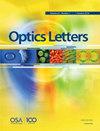疏散点源:应用于微球辅助超分辨率显微镜。
IF 3.1
2区 物理与天体物理
Q2 OPTICS
引用次数: 0
摘要
在对成像系统进行严格的电磁模拟时,来自点源或样本的蒸发波会自然地与传播波混合在一起。因此,很难区分它们的贡献。我们提出了一个仅由蒸发波组成的点源模型。为了说明该模型的潜力,我们将其应用于研究微球辅助显微镜(MAM)中的蒸发波贡献。我们清楚地证明了蒸发波在微球成像过程中的贡献。然而,我们也证明了这种贡献不足以证明超分辨率的合理性。两个近距离点源之间的破坏性干扰可能是关键的物理现象。本文章由计算机程序翻译,如有差异,请以英文原文为准。
Evanescent point sources: application to microsphere-assisted super-resolution microscopy.
In the rigorous electromagnetic simulation of an imaging system, the evanescent waves from a point source or from a sample are naturally mixed with the propagative waves. Therefore, their contributions are difficult to distinguish. We present a point-source model made of only the evanescent waves. To illustrate its potential, the model is applied to the study of the evanescent-wave contribution in microsphere-assisted microscopy (MAM). The contribution of the evanescent waves in the microsphere imaging process is clearly demonstrated. However, we also show that this contribution is not enough to justify the super-resolution. The destructive interference between two close point sources may be the key physical phenomenon.
求助全文
通过发布文献求助,成功后即可免费获取论文全文。
去求助
来源期刊

Optics letters
物理-光学
CiteScore
6.60
自引率
8.30%
发文量
2275
审稿时长
1.7 months
期刊介绍:
The Optical Society (OSA) publishes high-quality, peer-reviewed articles in its portfolio of journals, which serve the full breadth of the optics and photonics community.
Optics Letters offers rapid dissemination of new results in all areas of optics with short, original, peer-reviewed communications. Optics Letters covers the latest research in optical science, including optical measurements, optical components and devices, atmospheric optics, biomedical optics, Fourier optics, integrated optics, optical processing, optoelectronics, lasers, nonlinear optics, optical storage and holography, optical coherence, polarization, quantum electronics, ultrafast optical phenomena, photonic crystals, and fiber optics. Criteria used in determining acceptability of contributions include newsworthiness to a substantial part of the optics community and the effect of rapid publication on the research of others. This journal, published twice each month, is where readers look for the latest discoveries in optics.
 求助内容:
求助内容: 应助结果提醒方式:
应助结果提醒方式:


